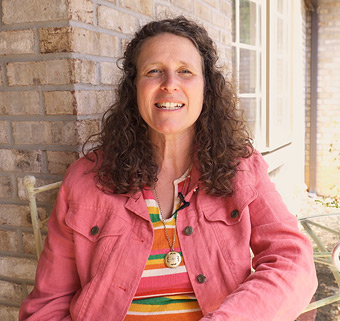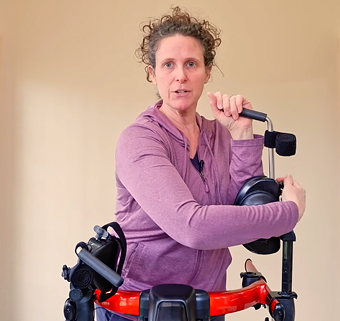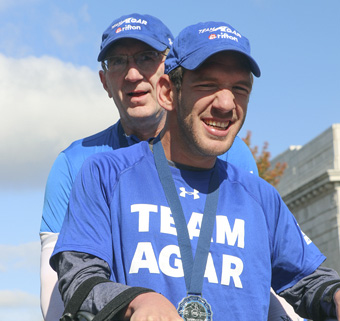Chest Prompt
Pacer Positioning in Depth
Cathy Ripmaster, MSPT demonstrates the chest prompt on the Rifton Pacer and discusses positioning for effective gait training.
Introducing the Chest Prompt
[00:04] Hello, it’s Cathy Ripmaster the physical therapist, and today I’m going to talk to you about the Rifton Pacer, and specifically the chest prompt on the Pacer. As you can see, I’ve stripped everything down on this dynamic Pacer so that it only has a chest prompt, so the other things just don’t get in the way. So I’m just going to talk to you about some basic features of the chest prompt, how it can be adjusted to fit the needs of the individuals that you work with.
Knobs and Straps
[00:30] The first thing I want to show you are the knobs here. There’s a knob right here. Sometimes when people are moving the chest prompt around, this knob can get brought into the front. And I prefer to have it in the back so that the individuals that I work with, their elbows don’t hit that knob; so I tend to always keep that knob in the back. The next basic thing I’d like to show you is this strap right here. There are two sides. And this chest prompt actually looks the same from the front and the back; except for in the front, it has this nice little strap that holds the two pads together. And that is how you’ll know it’s in the front. And the nice thing about this little strap, the function of that is that when you push down, it doesn’t separate the two different pieces of the chest prompt. So it holds it in place, if you have somebody that needs to lean against the chest prompt.
Upside Down or Right Side Up
[01:23] The next thing I’d like to show you is how I can adjust the chest prompt just being upside down or right side up. So the original design of it is that this is the right way to have it, so that there is a large space from where the bar that comes out and attaches into the bracket – there’s a large space here and then there’s a shorter space at the bottom. And this is really nice and padded, which is really nice. But sometimes I find that if my student has a shorter torso, that I need to flip this chest prompt. So especially for the younger students that I work with at my school, a lot of times I will have this already flipped, and that’s kind of my universal position. So I’m going to show you how to take that out. You just go ahead and unscrew this knob on either side of the frame. And sometimes you have to wiggle a little bit. But you’ll want to take it out of the frame. And you just want to flip it the other way so then now you can see with the frame being at the height that it is, that the chest prompt is a lot lower.
Height of the Chest Prompt
[02:43] So at this point, the chest prompt for me is kind of snug against my hips, and that would be too low. So I could either change the height of the frame, which doing that would be fine, except you don’t want it too high above the hips. You would like to have the frame height at the hip level. So if I do that, it’s a little bit better; and you can see that now the chest prompt is just right at my hip level, which still kind of like gets in the way for walking. So what I would do next, because I have plenty of space between my armpit and the top of the chest prompt, is that I would just hit this little white button right here on the chest prompt, and I would just raise it up. Right now I have two notches showing on this bar. And I would try to get two notches on the other side and see how that feels.
[03:38] This is really nice for me. It’s kind of below my chest level, which is comfortable. It is above my hips so that I’m not hitting my hips, and it’s not blocking my hips at all. And my knobs are in the back. And this strap is right here in the front. So this would be a great configuration for somebody. You may need to have it up a little bit higher if they don’t have good trunk control. But if they do have good trunk and head control, it’s nice to have this lower; because you’re kind of reducing the height of the prompt, which means you’re reducing the amount of support. So I would try to make the chest prompt as low as you can, as long as it does not interfere with the movement of their hips.
Location of the Bracket on the Bar
[04:22] Another thing that you can do, once we flipped it, is change the location of the bracket on the bar. So that just entails loosening up the knob that is on the bracket, that’s attached to the frame. And you can move it forward or backwards onto the frame. I have found that with the configuration of the new dynamic Pacer with this crossbar, that if my chest prompt is actually pushed all the way up and I need my armrests close, sometimes there’s not enough space and it gets really tight in here with the arms. So sometimes I might need to just push my chest prompt back just a little bit away from that crossbar, so I have more room for the arms. And I have just more flexibility with the adjustment that I have on the arm, if I have a little bit more space between this crossbar and the chest prompt.
Bracket Placed Outside or Inside the Frame
[05:25] Another thing that you can do is change the location of the bracket on the frame, of having it on the outside of the frame versus the inside of the frame. And you would change that depending on the width of the person you’re putting in it. Sometimes on the outside, which it is right now, it’s just too wide for that individual. So what you can do to change that would just be removing the bars from that bracket. And then you’re going to just take the knob off, drop it down, open it up, flip it around so it’s on the inside. And I’m just going to put the bar right back in. And then I’m going to do the same on this side – just flip the bracket to the inside. And that just makes it narrow. For me this is a little bit too narrow, so I would just open up the sides. And you may also need to open up the front or tighten that up; if you have it on the inside like I have it now, you might need to tighten that up. So for me, especially with my chest prompt that low, I actually will need to raise up my chest prompt.
Making Adjustments
[06:50] So once you get your individual in here, you might need to tweak all of these things. You might need to tweak them between days that you’re getting them in. So they might look so good one day, and the next day not so great. And you might just need to make some adjustments to it. These are really easy to adjust on the frame, not so easy to adjust and flip the height of this, or flip the brackets. You would actually need to take them out to do that. So that’s something to think about prior to getting them in; and also to think about when you have to share Pacers between individuals if you’re in a school setting, which is the case for me. So sometimes that adjustment needs to happen before you get them in.
One Bracket Inside, the Other Bracket Outside the Frame
[07:35] So now we have learned that you can change the width of it from the inside versus the outside. But another thing is that sometimes I have individuals that this arrangement – all in the inside or all on the outside – is still just not quite right. So sometimes I would put a bracket on the outside on one side, and on the inside on the other side. So I would make a decision about which ones I would have on the inside versus the outside if they have a scoliosis. For instance if I have somebody that is leaning over to the right – I would have the bracket on the inside on the right side, so that you can push them up on the right side. But you could have them out on the other side.
[08:24] One thing that is a little bit tricky if you have this configuration is that it may shift their pelvis because they’re going to be over to one side in the frame a little bit. But for the most part that doesn’t make a big difference in their hip position. But it could make a big difference if you have somebody that has a curvature of their spine, to help them be a little bit more upright. If that is the case, you could also make one side lower than the other, and so it could be a little bit asymmetrical. So you could have one side in and also that same side up a little bit higher, as long as it’s not too high into the armpit. So you can make that adjustment.
One Bracket Farther Up
[09:02] I have also found that for some students that have a rotation of their spine, sometimes in order for them to walk, I might need to make one bracket farther up than the other bracket. So you can see, it’s a little bit skewed – and that is okay too. It does not have to be perfectly centered. What you do need to do is make adjustments so that it can be functional. So depending on the person that you’re working with, you can make those little tweaks.
Chest Prompt Angle
[09:35] Another thing that you can do is you can rotate the chest prompt. So there are these little grooves that are in these bars that come out. If you loosen the knobs, you can adjust the angle of this chest prompt. And I actually play around with this quite a bit. If I have a student who is first learning to walk – and they need to be forward in order for their momentum to keep them forward – I might tilt them forward a little bit, so they’re already leaning forward, and then just enough; that gets them to take some steps.
[10:15] If I have a student who has a kyphosis and they’re in here and they want to be leaning, a lot of times I will actually tilt their chest prompt up so that it kind of opens their chest up. And at that point, I would also have their armrests up higher – and I’ve explained that in another one of the videos. So having the chest prompt angled up helps with that. But if you’re angling the chest prompt up for a kiddo, who might have a kyphosis, I would also make it so that the back is also opened up a little bit, so that allows them to drop their back into the chest prompt.
Reducing Chest Prompt Support
[10:55] If you have a student who has pretty decent trunk control but might need a little bit of support here and there, I might even just put the brackets on the outside of the frame. And what that does is it allows a little bit more space so they can move their trunk a little bit; but they’re still protected and they’re not going to fall over to the side. But it allows them that freedom of movement, which also might help them move in the Pacer a little bit more.
[11:22] So I could reduce the prompt by opening up on the sides, but I can also reduce the prompt by actually having the back of the backrest open when they’re walking. A lot of times I will do that if I’m kind of progressing a student and I would like them to work on their trunk a little bit more. And if I’m standing right behind them, I might just open up the back rest so that they’re actually having to keep themselves forward. You could also do that in the front, as well – just opening up the front so they have to control their movement, but the sides are still stable so that they couldn’t fall laterally. Again, I would do this under supervision. I wouldn’t necessarily leave a student that is not proficient with that type of skill – of walking – without the support, if you undid the front of the Pacer or the back of the Pacer.
Thank You
[12:17] So those are just a few ideas of how you can progress them and reduce their prompts, like we do in the MOVE™ Program. I hope this was helpful for you today, and I hope that you check out some more of the videos that I’ve made to show you how to use pieces and parts of the Rifton Pacer. Thanks so much.



